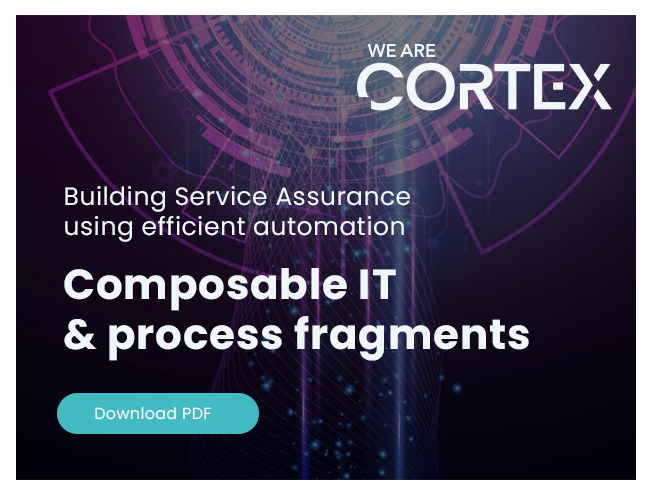How to reduce risk across your business by implementing best-practice Automation, and also minimise the risks of deploying Automation itself.
Today’s need for immediate gratification when it comes to customer experience has accelerated the Automation of business processes. Such Automation, when implemented effectively, can reduce risk across your business as well as helping you transform operating performance. Yet Automation, itself, can bring its own risks, and its delivery can also be difficult.
A classic example is the disconnect between business process people and technical people during implementation. All too often, well-defined Automation use cases unravel when they’re handed over to technical teams for execution. The techies prioritise technical task Automation and often lose sight of the underlying business objective. Over weeks and months, many such projects drift away from their original objectives, and – indeed – many take too long to be delivered anyway and are then no longer relevant.
That’s why it’s so important to keep Process Automation in the hands of business users as much as possible. Yes, technical people can and should be involved, but the focus should be on effective business process, not necessarily technical innovation. Moreover, you might want to keep human oversight on some of your automated processes, especially to begin with, to make sure they’re working as intended.
Put Automation into the hands of your process people…
So how would it be if the people that currently owned your business processes were given the tools they need to automate them too? For example, the people in your accounts team would take ownership of the Automation of bills being produced and sent out, for example. And, meanwhile, your customer services team would own the Automation of logged customer activity being fed into billing.
Put the best people in control…
Each team that plays its part in any process – billing, in this example – would take ownership of the Automation of its own role. That way, the best business expertise would be applied to the Automation at every stage of the process, helping ensure it was done as effectively as possible. And then each of those best-practice departmental Automations could be joined together in one end-to-end process.
To achieve that, you need strong user controls, based on individuals’ job roles, where they are given access only to the parts of the process that they’re responsible for. That mitigates the risk of people who don’t know what they’re doing meddling and breaking things.
Take the risk out of process mapping…
You also need an easy-to-use, intuitive process mapping system that these business users – who may only have rudimentary technical skills – will feel confident with. Moreover, those tools would ideally help users validate and debug what they’re doing, in a risk-free way, so they can experiment until their processes work perfectly. Indeed, it would also be best if you can enable technical oversight and collaboration, where relevant colleagues can see users’ process modules and help perfect them.
Start anywhere and grow quickly…
Note that this approach means you can start anywhere. You can automate any part of any organisational process from within any of your individual lines of business. It won’t necessarily matter to your customer services team if your accounts team has automated its bill production and despatch. Customer services can keep their process manual. Yet, when they get around to automating their billing feed, that will simply extend the automated process one step further into your business.
Keep a qualified human in the loop…
In turn, that flexibility over what you automate will mean you can also apply extra caution. You can automate only the things you are most confident about first, and leave anything where you want to keep a human in the loop for later.
Indeed, in an ideal world, you’d still be able to maintain some level of human oversight for processes that you automate. So you’ll want a system that can be configured to present some cases for human approval under certain circumstances – say, to approve the paying of sums over a certain amount. Additionally you may want a human to be alerted to so-called ‘exceptions’, where the system – as currently configured – doesn’t know what to do.
These ‘guardrails’, as they’re known, will enable you to both become more confident that your process Automations are working correctly, and also to extend their functionality to cover every case.
In both cases, you’re ensuring effective Automation with minimal risk. As your confidence in your Automation grows, you will feel less and less need to watch over it. And, of course, as your Automation extends across your business, you can be more and more sure of what the results will be. Automation, by definition, is not prone to human mishap so, once you have confidence that it’s working correctly, you can guarantee the right results, every time.
CORTEX does it all…
You can achieve all these goals with CORTEX’s Automation platform. It features a highly intuitive, graphical, drag-and-drop user interface, where users can build business processes using visual process-mapping symbols. Strong role-based access controls give the right people access to the right processes and systems. Moreover, your technical people will be able to create usable process modules from the underlying technology.
There are verification and debugging tools built in to the CORTEX platform, along with hyperlinked help text. Indeed, CORTEX will intelligently validate the logic you build, identify dependencies between process flows you build, and can warn you if you’ve not got the flow you think. When it comes to implementation, CORTEX also offers powerful simulation capabilities for numerous external systems. And all of your development work can be done in a fully sandboxed environment to ensure zero risk of data loss.
Crucially, when process modules are created, they can be stored in the CORTEX Repository. This is a collaborative space where other relevant people can come in and sense-check modules. So, technical people can test Automation modules that other people have created. Lines-of-business colleagues with similar access rights can work on modules too. There’s full traceability over who made what change and when, with a graphical difference viewer, and complete version control.
Modules can be duplicated, edited, withdrawn, and – ultimately – signed-off as viable Solution Packages. And you will have to appoint one or more CORTEX gatekeepers to approve Automations as signed-off Solution Packages, so you know they’re ready for production and present no risk.
CORTEX is easy and risk-free to deploy…
From an infrastructure perspective, CORTEX is highly flexible and highly resilient, enabling you to achieve a wide range of business objectives safely and effectively. The software operates in a resilient cluster, with load-balanced nodes that can be run in different geographical locations, under different security configurations, and more. Every transaction can be recorded, enabling you to create a fully comprehensive audit trail. And the highly consolidated CORTEX platform can do this effortlessly, unlike other more modular solutions, making your life as simple as possible.
Indeed, the CORTEX platform enables the rapid implementation of coherent Automation in your business processes – and their fast re-configuration – precisely because it is so flexible, and has such a strong governance framework.
Read more detailed explanations of how CORTEX enables a whole range of powerful outcomes in our coming series of articles: working with uncertainty, tracking and reporting value, planning for Agile Automation, integration strategies, and human in the loop. Also, if you missed it, why not read our first article in the series: Process Automation that Means Business.
Alternatively, get in touch to find out more.







